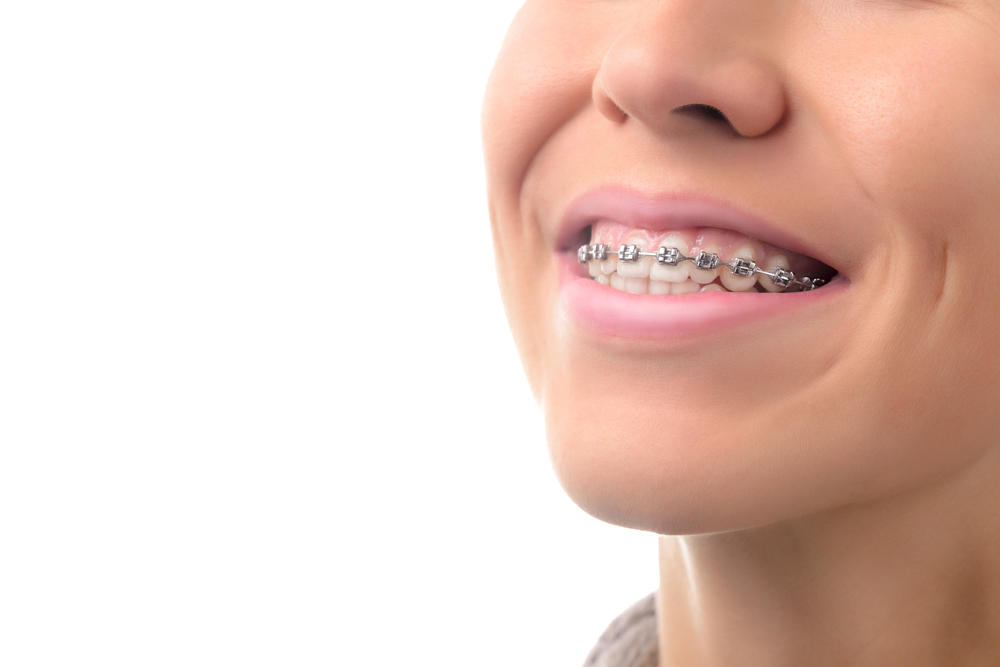How To Fix A Misaligned Jaw

Many orthodontic patients suffer from a misaligned jaw that affects how teeth sit in the mouth and causes bite problems. Overbites, where the upper teeth protrude, and underbites, when the lower teeth sit out farther than the upper teeth, can cause physical and emotional discomfort. If left untreated, a misaligned jaw can affect how you eat, speak and sleep. Luckily, there are many types of orthodontic treatments and appliances that are used to correct misalignments and give you your confidence back. Find out what to do if you have a misaligned jaw with this guide!
What A Misaligned Jaw Looks Like
Many people receive orthodontic treatment to fix their crooked teeth, but braces can also resolve bite issues, as well. Braces are great ways to fix misaligned jaws in children and adults and help prevent the consequences of underbites and overbites. Misaligned jaws are often painful and obvious, and many children are unfortunately teased by their peers because of it. Our “bite” refers to how the upper and lower teeth meet together, which influences how we chew, eat and speak. The two most common bite problems are an underbite and overbite, with an underbite occurring whenever the lower jaw sits in front of the upper jaw while the overbite happens when the upper jaw protrudes abnormally over the lower jaw. While these deformities look awkward, they have consequences that are more serious than aesthetic concerns. Underbite create a bulldog appearance as the lower jaw protrudes out, which not only puts a lot of stress on the joints but also causes tooth wear. Overbites create buck teeth that stick out so far that they can easily break and make it difficult to close the mouth and lips. They also create an elongated face, speech problems and increase the likelihood of tooth decay as oral tissue dries out. Depending on the severity of the misalignment and which bite is involved, treatment options such as braces, cosmetic dentistry and surgery are common ways to fix the problem.
Treatment Options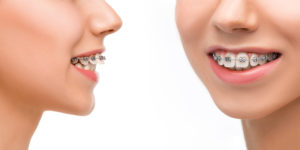
For crooked or crowded teeth and misaligned jaws, braces are the standard treatment performed for most patients. Traditional braces with brackets cemented to the teeth and attached with an archwire help with overbites to straighten the upper front teeth and bring them into a non-protruded position. For extreme cases of overbites and underbites, headwear braces may be necessary. These devices are made with internal and external wires, along with straps that fit over the head and neck, to move the upper jaw either forward or backward. Headwear braces are typically worn for 12-14 hours a day, but are only needed whenever traditional braces cannot fix misalignment. For underbites, an upper jaw expander is recommended to widen the palate of the mouth so that the lower teeth move back into position. The expander is placed in the upper palate of the mouth and widened each night with a special key, and after one year, the palate should be wide enough for both the upper and lower jaws to fit together. For the most serious cases of jaw misalignment, orthognathic jaw surgery will be required. Plates, screws and wires will be surgically placed into the jaw by a maxillofacial surgeon to permanently correct bite problems, which will greatly improve speech and sleep.
Importance of Orthodontic Visits
While many bite problems are obvious, some are so slight that detection will be hard to notice. In these cases, it’s important that children and adults have regular orthodontic visits so that teeth movement and development can be monitored. Orthodontic visits, especially in young children, are essential to observe incoming teeth, reduce the risk of impacted teeth, monitor jaw development and detect hidden dental issues. Not only will your teeth be examined, but your jaws and mouth will be reviewed for signs of underlying conditions, decay and disease, as well as thoroughly cleaned. These visits also provide patients the information they need to establish good dental habits early on to keep their teeth healthy and free from decay both during and after orthodontic treatment.
Get Straighter Teeth With Our Help!
At Belmar Orthodontics, we specialize in helping children and adults alike fix malocclusion, adjust misaligned jaws and get the smiles that they deserve. Whether you or your child has an underbite, overbite or crowded teeth, our team can help you remedy any issue that you are experiencing. Through specialized orthodontic treatment plans and advanced appliances, your mouth issues can be fixed within a short period of time. Call our office today at (303) 225-9016 to get a straighter smile today!
Signs That You Might Need Braces
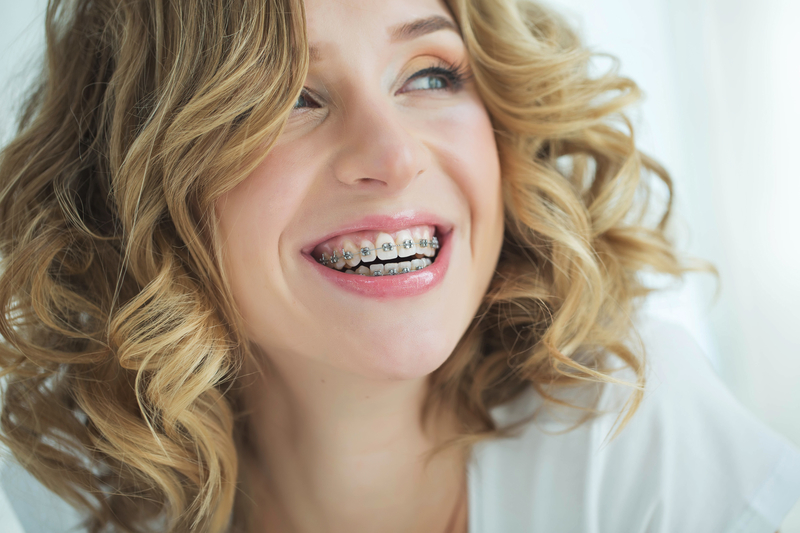
For many patients, getting braces is a big decision that affects oral health. How do you know whether you or your child needs braces, though? Some symptoms are obvious: misplaced or crowded teeth, or teeth that don’t meet normally. Other signs that you need braces are more inconspicuous, though, such as biting the cheek or a jaw that pops or shifts. While some of these symptoms are more serious than others, orthodontic care is the way to go to alleviate pain and correct any underlying issues. Learn about what signs you should be looking for to decide if braces are right for you with these tips!
What To Look Out For
As our teeth begin to erupt at a young age, they can fill into improper spaces or cause problems with adjacent teeth. Crooked or misaligned teeth aesthetically aren’t very pleasing for people, and most patients end up receiving orthodontic treatment during some point in their lives. Orthodontic problems don’t always mean crooked teeth, though. While there are some obvious signs that you might benefit from orthodontics, such as crowded teeth or an underbite/overbite, there are other symptoms that are less noticeable but equally as undesirable. The American Association of Orthodontics recommends that children have their first orthodontic visit between the ages of 7 and 8, but if certain complications are present, your child does not and should not wait until that age to be seen. If you have a young child, look for some of the following symptoms that warrant orthodontic care:
- Thumb or finger sucking
- Early, late or irregular loss of baby teeth
- Difficulty in chewing or biting
As children age, orthodontic problems will begin to show themselves, but some don’t appear until adulthood. No matter your age or prior orthodontic care, there are other symptoms that indicate a problem and should be addressed by an orthodontist. If you are struggling with a popping jaw, have to breathe through your mouth on a regular basis, are constantly biting your cheeks, and/or noticing teeth or jaws that are out of proportion to the rest of your face, you should have an orthodontic consultation. While many of these symptoms seem harmless or aren’t very noticeable, they can have long-term consequences that can negatively affect your oral health. Braces can remedy these issues so that your oral health isn’t compromised. It’s never too late for you to take charge of your oral health and get the smile that you deserve!
Advantages of Early Orthodontics
Not all kids will need orthodontic care, but many will. Meeting with your child’s dentist early on will help them determine whether your child would benefit from orthodontic treatment. If you have a child who needs an orthodontic issue remedied, there are certain advantages that come after receiving braces. Having your child evaluated by an orthodontist can help he/she observe the progress of incoming teeth, guide teeth into their ideal positions, monitor face and jaw development, detect hidden dental issues and reduce the risk of impacted teeth. For young children, orthodontic visits can sometimes be scary. Nonetheless, child orthodontic visits are simple and non-intrusive, so as to keep your child comfortable and happy. At Belmar Orthodontics, we do our best to give your child the care they need while making sure that their fears and questions are addressed. For adolescents, our options at include aesthetically-minded treatment options that will help your teen feel less self-conscious about braces. Braces can sometimes be seen as “dorky” or “uncool” for teens, but the list of options your teenager can choose from will give them plenty of choices to get straight teeth while still looking cool. Good oral health habits are started at a young age, and bringing your child in to see the orthodontist will help them establish those habits that will last a lifetime.
How You Can Benefit From Adult Orthodontics
Against popular belief, braces and orthodontic care aren’t just for kids and teenagers! In fact, one in five orthodontic patients is an adult; in just the U.S. and Canada alone, more than a million orthodontic patients are adults! You, as an adult, can benefit from the same care that young patients do and fix the orthodontic problems that you’ve been suffering from since childhood. As long as your teeth are healthy, you can receive orthodontic treatment at any age. The most common benefits of adult orthodontics include the following:
- More discreet treatment methods
- Correction of lifetime dental issues
- Faster treatment time than previous treatments
- Increased confidence and self-esteem
It’s important to note, however, that any previous orthodontic problems, such as periodontal disease or decayed/missing teeth, will need to be addressed before an orthodontic appliance can be placed. Once those issues are fixed, you’ll be fitted with braces and can continue your life just as usual. If you so choose, you can even opt in for hidden lingual braces or Invisalign clear, which will get you the straight teeth that you want while being completely unnoticeable. Speak with your orthodontist to determine which braces would be best for your needs before making any decisions.
Staying On Top Of Your Oral Health
Before any patient can receive orthodontic treatment, the health of their teeth, gums and mouth will first be evaluated. For this reason, it is important that children and adults alike are brushing twice a day and flossing on a nightly basis. The foods we eat also affects our oral health, as well. Especially during orthodontic treatment, certain foods, like sticky or sugary candies and food, can damage orthodontic appliances and make it easier for tooth decay to develop as plaque builds up on teeth. Brushing and flossing will partly diminish the effects of these foods, but not entirely. Make sure that you and your children are eating a healthy diet with minimal sugary snacks to avoid dental complications during treatment.
To ensure good oral health during and after orthodontic treatment, schedule an appointment with Belmar Orthodontics at (303) 225-9016 for a consultation.
Braces With Oral Health Problems
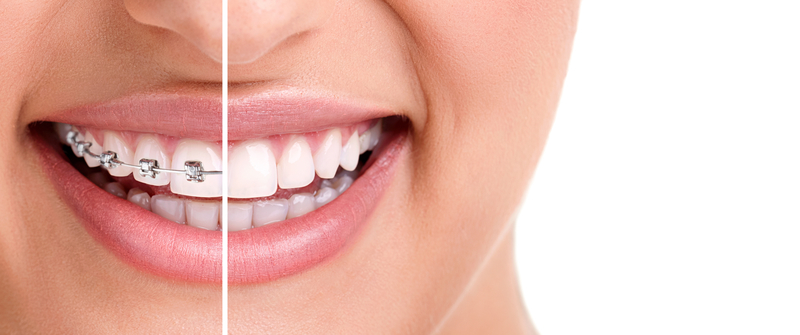
Did you know that your oral health can affect your overall health? Poor oral health can even worsen health conditions you already have such as diabetes or cardiovascular disease. That is because oral health and overall health are highly connected. Your oral issues can become better with braces, but that is only if certain oral health problems are corrected beforehand. Patients can also develop oral health problems if they don’t have the right knowledge with proper braces care. Use these tips to avoid oral health problems with braces and find out how we work around current problems to provide you with a straighter smile!
Oral Health Goals
Did you know that orthodontic treatment can give you a healthier mouth? We know that braces help straighten your teeth, but they can also improve the health of your gums and teeth. When you have crooked and crowded teeth, this makes cleaning your mouth more difficult. This can cause serious oral health problems, such as tooth decay, periodontal disease, and tooth loss. Whether you have straight or crooked teeth, before you let an orthodontist start working on you, there are some important oral health tips to be following before any work begins:
- Eat a healthy diet that limits sugary beverages and snacks
- See a dentist regularly for prevention and treatment of oral disease
- Brush teeth twice a day with fluoride toothpaste
- Floss daily
- Discuss changing certain lifestyle practices, like smoking and using oral piercings
Types of Braces
Braces are a big commitment, and you want to make sure you’re using the correct ones whenever you get them put on. Each of us is a different size and shape, and are mouths aren’t any different. Because of this, there are various types of braces for different sizes and shapes of mouths for children, teenagers, and adults. The four most common types of braces are: traditional, short-term, clear, and Invisalign/ClearCorrect.
Traditional braces are those that we see on a daily basis: a system of wires and brackets that are bonded to our teeth. This type of braces are the most cost-effective, reliable, and are best suited for severe orthodontic issues. Short-term braces are recommended for those patients who wish to align just their front six teeth-the ones that others see the most. These are used for the shortest amount of time (less teeth to align), but there is no adjustment to your occlusion (bite). So if you have a problem with an under/overbite, short-term braces may not be for you. Clear braces are similar to traditional metal brackets except that they use ceramic brackets that match the color of your teeth. These braces have a high aesthetic appeal for those who don’t want to be seen wearing braces, plus they are highly resistant to staining. Invisalign//ClearCorrect straighten your teeth without the traditional wire brackets, and are completely removable, which makes cleaning your teeth a cinch. This type requires more responsibility for the wearer, but if you’re committed to the strict wearing regimen, you can have a straight smile in as little as 12 months!
Taking Care of Your Braces
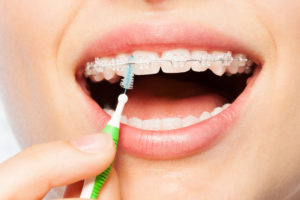
While similar to managing our oral health, maintaining our braces has a few extra steps. To maintain good oral health with braces, it’s important to adopt good oral hygiene throughout the entire process. Brushing after every meal is one of the most important but most overlooked steps in maintaining good oral health. When eating, food particles get stuck in between our teeth and our braces, which can cause staining and bacterial backup between our teeth. Using a regular soft brush in an up-and-down motion on each tooth will do the trick. Secondly, use threadable floss or a floss threader. These tools allow you to get between each tooth and underneath the wires to clean out any food that may be trapped there. Insert the threader between two teeth and move back and forth until the food is released. Lastly, use a proxabrush, or a “Christmas tree brush.” Place the proxabrush between two brackets, below the archwire, and brush up and down. Like the threader, this will also help loosen up any food that may be stuck between your teeth.
A great way to ensure that your braces don’t break and that you don’t get unwanted gunk stuck in them is to watch what foods you’re eating. Foods that are hard, sticky, or high in sugar should be avoided. Eating food that is high in sugar can cause cavities when wearing braces, which can lead to more dental work that you would need to have done. Furthermore, patients with braces should limit between meal snacks and avoid food that could bend the wires, such as caramel, nuts, chewing gum, ice, or popcorn.
When To See An Orthodontist
Now that we understand more about the importance of our oral health, plus the different types of braces, when should we make an appointment with an orthodontist? Many times, we only schedule a time to see an orthodontist whenever our teeth are crooked and we want them straightened. But there are other factors that influence when we should start thinking about getting in to see the doctor:
- Jaws that shift, make sounds, protrude, or are recessed
- Speech difficulty
- Biting the cheek or biting into the roof of the mouth
- Facial imbalance or asymmetry (features out of proportion to the rest of the face)
- Inability to comfortably close lips
- Grinding or clenching of teeth
As mentioned earlier, these are signs that your oral health might not be up to par like it should be. Meeting with your orthodontist and discussing these issues will help them better treat you with one of the four types of braces that we discussed previously. The sooner you get in to see your orthodontist, the sooner any pain or discomfort can be evaluated, treated, and extinguished.
Meet Your New Year’s Resolutions With Our Help!
Belmar Orthodontics can help you on your path towards having a straighter smiles and better oral health. With reputable orthodontists, manageable treatment plans, and services for children and adults, we can help you get the smile that you deserve! Call (303) 225-9016!
What Is Interceptive Orthodontics?
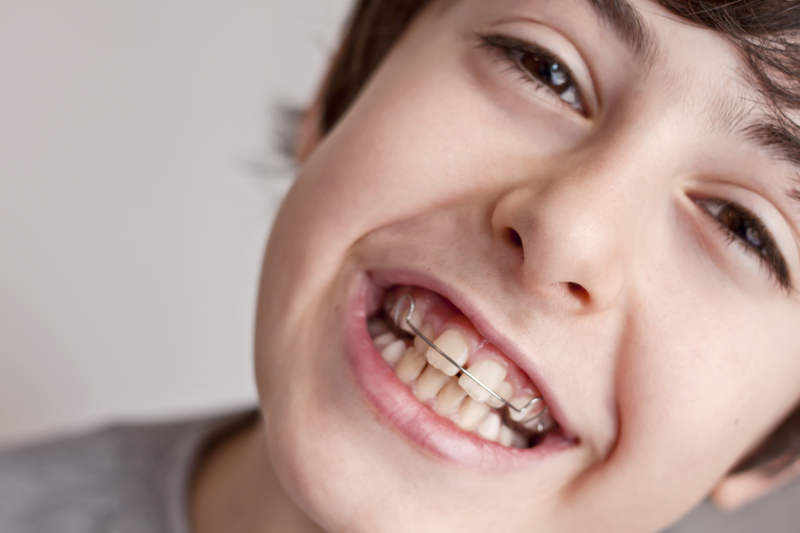
Millions of people each year receive interceptive orthodontics to correct bite and alignment issues. You may know these braces by the name of “child orthodontics” or “Phase 1” orthodontics. You might even know some children who have braces. Many children need orthodontic help to ensure that their bite lines up correctly for a healthy mouth. There are also other reasons a child might need interceptive orthodontics, such as receiving them to help make room in the mouth for the adult teeth to come in. Find out what interceptive orthodontics entail and if your child needs them!
Choosing to Get Braces
Many teens wear braces each year to straighten their teeth once the permanent, adult teeth have come in. Most permanent teeth have come into the mouth by age 12 or 13. However, braces aren’t only for teens who are wanting a straighter smile. In fact, about 1/4th of all people with braces are children and about the same amount are adults. Many more people than you would think wear braces, especially when “invisible” options like Invisalign and lingual braces exist.
When you choose to get braces, you are making a smart decision for yourself and for your oral health. Many people think that braces are only meant to help the teeth become straighter. Although that is one of the main reasons, there are many benefits of braces. These appliances are used to help fix crooked teeth, but also bites and mouth alignments that aren’t in proper position. There are orthodontic appliances when a patient only needs a few months to change a dental problem and there are even surgical options for orthodontics. But, why so many options when it comes to orthodontics?
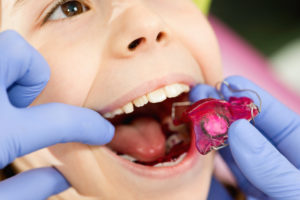
Benefits of Braces
We love to allow our patients the freedom to correct their smiles how they want, when they want. You are never too old to get braces. Children get them all the time to fix bite problems, only to get them again later on for straightening. Adults wear them, especially if they are wanting to advance their careers. Studies show that an employer is much more likely to take a potential employee if they have a straighter smile.
Orthodontic treatment is also proven to make people more confident in their smiles and in themselves. When patients get straighter teeth and fix dental issues, they smile more, talk more and exude more confidence. This can change someone’s entire life, especially a child’s.
What Are Interceptive Orthodontics?
Interceptive orthodontics is another name for “child orthodontics”. If you are surprised that children get braces, don’t be! The American Association of Orthodontics actually recommends that children have their first orthodontic visit between the ages of 7 and 8. This is when many of the baby teeth are falling out, and a perfect time to see how permanent, adult teeth are coming in. An orthodontist can use the first orthodontic appointment to check your child for bite and alignment problems before they become severe as a child ages into a teen and then an adult.
When certain orthodontic problems like crossbite or underbite, are left untreated, these conditions can become more severe, complicating issues. Interceptive orthodontics aims to check children while they are young for problems that will become severe in the future. They “intercept” a patient before that point, and fix the problem much easier than if a child’s mouth had grown more. Interceptive orthodontics checks children at an early age to:
- Observe the progress of incoming teeth
- Monitor facial and jaw development
- Guide incoming teeth into their ideal position
- Detect hidden dental issues
- Reduce the risk of impacted teeth
- Decrease the risk for permanent tooth extractions
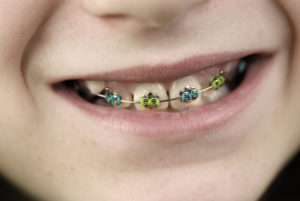
Considering Interceptive Orthodontics?
Do you want to give your child the best chance possible to have a healthy mouth? Make sure you involve an orthodontist in their early-childhood development! Interceptive orthodontics is not needed for every child, but for the ones who need it, it can change their life. If a child has enough crooked teeth, it can create uneven pressure on those teeth when they bite and chew. This can lead to broken, fractured, chipped and cracked teeth. The teeth are also much harder to clean when they are crooked, leading to tooth decay and gum problems in young children.
If a child’s bite is not even or their alignment is off, it can also lead to broken teeth. When the baby teeth aren’t aligned correctly, the adult teeth won’t come in right. Children can have uneven bites form from thumb-sucking and similar habits that curve the teeth outward. This can create problems biting, chewing, talking, and more. Speech impediments can form and become worse over time if the problem isn’t corrected. No parent wants speech problems, tooth decay or dental injuries to happen to their child, and they never have to. Call Belmar Orthodontics today at (303) 225-9016 for your child’s comprehensive orthodontic exam and see if they need interceptive orthodontics today!
5 Signs You May Need Braces
How do you know when you need braces? Do you know? When you look in the mirror at your smile, do you like what you see? Are your teeth straight or crooked? Is your bite comfortable? Do any of your teeth collide when you bite, swallow or chew? Sometimes it is easy to spot signs that you may need orthodontic treatment, and at other times the signs might not be readily apparent. At Belmar Orthodontics, we work with you and your general dentist to determine the best course for your oral health needs. Learning what signs to look out for that could indicate that orthodontic treatment is needed can help you keep your mouth healthy and your smile bright.
Crowded Teeth
One of the most obvious signs that you need braces is needed is overcrowded teeth. Teeth that are overcrowded don’t just pose a cosmetic problem, but can pose real health threats to you. This is because food is more easily trapped in crowded teeth and harder to remove with regular teeth-cleaning methods. Trapped food leads to tooth decay, gingivitis, periodontal disease, bad breath, and can negatively affect self-esteem.
Gaps In Between Teeth
Gaps in between teeth often indicate that the upper and lower jaw are not fitting together properly, a condition commonly referred to as malocclusion. Genetics, thumb-sucking, mouth tissue formation, and other conditions can also cause gaps between the teeth. Closing these gaps not only helps to improve the aesthetics of your smile, but it also can help to fix your malocclusion problems. Gaps between teeth also leave the gum tissue between the teeth exposed and at more risk for being affected by plaque, inflammation and infection. You need braces to help close these gaps.
Bite Issues
When we refer to your “bite” we are referring to how your upper teeth and lower teeth meet and interact when your mouth is closed. 70 percent of the population has a malocclusion problem–incorrect bite–but this is not a condition that one should ignore. Improper bite can cause irregular wear of your teeth, jaw issues (TMJ pain) and chronic headaches. Malocclusion can also result in injury to your teeth as they improperly collide with one another as you chew or speak. Proper speech development can also be impeded when your bite isn’t functioning properly. Orthodontic treatment improves the function of your smile, and the appearance, benefiting you in numerous ways.
Jaw Pain
Jaw pain and headaches are often the result of a misaligned bite. When your jaw is not fitting together properly it can slip out of place easily, causing tension when you are sleeping. Jaw pain can also result from a condition called TMJ disorder. TMJ, or temporomandibular joint disorder, involves your body’s temporomandibular joint (TMJ) which connects your jawbone to your skull much like a sliding hinge. When the hinge mechanism that connects the upper and lower jaw isn’t working you can experience pain in your jaw joint and in the muscles that control jaw movement. Temporomandibular Disorder (TMD) refers to a variety of conditions that affect TM joints, jaw muscles and facial nerves. During your consultation with Dr. Hardy he can evaluate your teeth and jaw alignment to see if your jaw pain is a result of poor alignment and determine if you need braces.
Difficulty Chewing or Speaking
Severe cases of malocclusion can affect the way you chew, speak and swallow. Do you–or your child–find yourself biting your cheek or the roof of your mouth when you are chewing? Do your teeth ever collide when you chew sending jarring sensations through your whole face and/or jaw? Do you (or your child) have problems with slurred speech, or saying certain words? If you answered yes to any of these questions, chances are that you need braces. All of these issues can be the result of a bite that is misaligned. Once you correct the jaw alignment, these symptoms correct themselves, but they won’t correct on their own!
What Caused Me to Need Braces?
One of the most common questions that we are asked is, “What caused my teeth to be crooked? Or, “What caused my jaw not to be aligned correctly? Unfortunately, we don’t always know the exact cause, but most orthodontic issues are genetic; you inherited those space or bite problems! Other issues develop overtime due to: thumb- or finger-sucking, dental decay, mouth breathing, injuries, or poor nutrition. The good news is, regardless of the cause, Belmar Orthodontics in Lakewood can correct your teeth/bite problems and restore your proper functionality with a beautiful smile!
Think You Need Braces? Call for a Free Consultation
If you have seen one or some of these signs that you may need braces, give us a call! Life with braces brings exciting changes, and sometimes some challenging adjustments too, but the end result is a healthier you! Belmar Orthodontics can help you obtain a healthy, functional, attractive smile. If you think you need braces, our online patient education can help answer any questions you may have, and our friendly staff is always available to help. Call 303.225.9016 today to learn more about braces or to schedule an appointment. Dr. Hardy is committed to your care and will help you reach your smile goals as quickly and efficiently as possible if you need braces.
